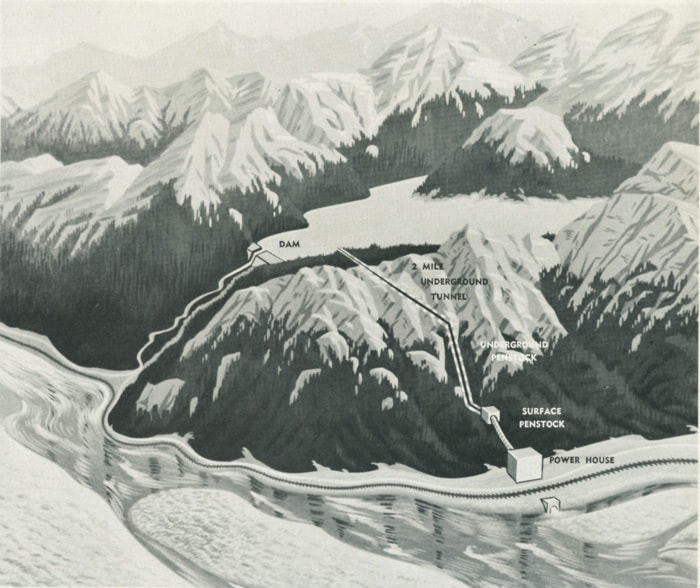Kimberly Campbell and Inge Wilson
Contributors
When driving between Hope and Bridal Falls on the Trans-Canada Highway, many curious travellers have wondered what exactly that large, fortress-like building along the roadway is. The building, a BC Hydro Powerhouse, generates hydro-electric power with water from Jones (also known as Wahleach) Lake.
After the Second World War, the BC Electric Company (now BC Hydro) vastly increased its generating capacity in order to meet increased domestic and industrial demands for electricity. In November 1950, B.C.E president, A.E. Grauer, announced a $10-million hydro-electric project at Jones Lake that would provide an additional 80,000 horsepower to the B.C.E. grid – the energy needed to light one million 60 watt lamps!
The high altitude, glacier-fed lake provided the ideal spot for a reservoir. Located at approximately 2,106 feet (642 meters) above sea level, Jones Lake would be the highest hydro-electric “head” in Canada. In order to transport the water, a 13,500-foot tunnel would be drilled through Four Brothers Mountain, passing the contents of Jones Lake through a brand new generating station – the largest in western Canada.
In addition to constructing a 1,375-foot-long, 55-foot-high rock-fill dam, the tunnel, and the generating station, B.C. Electric also announced that the project included two million dollars for the construction of a new transmission line linking the Wahleach Power Station to the main transmission system in Surrey. Based on a Swedish design, it would be the first ultra-high voltage line to be built in North America and would be capable of carrying 345,000 volts – over 50 per cent more than standard transmission lines!
Despite the relatively short and efficient construction period, the Wahleach project did not escape the minor snags that befall any large project. In late November 1951, six construction workers became trapped when a pile of timber being slid down a steep section of the tunnel became jammed. The timber, which was being removed to make way for a cement tunnel lining, was cleared after the six had spent 10 hours trapped in a section of the tunnel with a 48 degree incline. None of the workers were injured, but they were tired and hungry. Just a few months after, in January 1952, the tunnel builders walked off the job demanding higher wages. After five days, the miners returned to work while negotiations continued.
On Dec. 4, 1952, Premier W.A.C. Bennett officially opened the Wahleach Hydro-Electric Plant with the turn of a knob. Bennett, Grauer, and B.C.E. chief engineer, Tom Ingledow, were joined by over 300 officials at the Hotel Vancouver where a radio-telephone circuit connected the switch panel to the power plant for the grand opening. Grauer noted that “new engineering frontiers have been crossed and new knowledge gained…which ensures ample electricity for better living.”
The Wahleach Power Project was a major step forward in the electrification of British Columbia as it added 82,000 horsepower of electrical energy to the B.C.E. grid, bringing the total to 605,800 horsepower – more than double what had been available just five years before in 1947. The project created millions of man-hours of work for British Columbians in engineering, manufacturing, and general labour in order to complete the 18-month project that provided 14 per cent of British Columbia’s electrical capacity – and it all took place in Hope’s backyard!
Today you can access the Jones Lake BC Hydro Recreation Site by travelling nine kilometres up a steep, gravel 4x4 road from Laidlaw.
